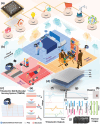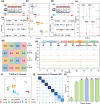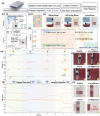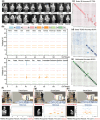Triboelectric Mat Multimodal Sensing System (TMMSS) Enhanced by Infrared Image Perception for Sleep and Emotion-Relevant Activity Monitoring
- PMID: 39698892
- PMCID: PMC11809373
- DOI: 10.1002/advs.202407888
Triboelectric Mat Multimodal Sensing System (TMMSS) Enhanced by Infrared Image Perception for Sleep and Emotion-Relevant Activity Monitoring
Abstract
To implement digital-twin smart home applications, the mat sensing system based on triboelectric sensors is commonly used for gait information collection from daily activities. Yet traditional mat sensing systems often miss upper body motions and fail to adequately project these into the virtual realm, limiting their specific application scenarios. Herein, triboelectric mat multimodal sensing system is designed, enhanced with a commercial infrared imaging sensor, to capture diverse sensory information for sleep and emotion-relevant activity monitoring without compromising privacy. This system generates pixel-based area ratio mappings across the entire mat array, solely based on the integral operation of triboelectric outputs. Additionally, it utilizes multimodal sensory intelligence and deep-learning analytics to detect different sleeping postures and monitor comprehensive sleep behaviors and emotional states associated with daily activities. These behaviors are projected into the metaverse, enhancing virtual interactions. This multimodal sensing system, cost-effective and non-intrusive, serves as a functional interface for diverse digital-twin smart home applications such as healthcare, sports monitoring, and security.
Keywords: deep learning; digital twin; multimodality; smart home; triboelectric sensor.
© 2024 The Author(s). Advanced Science published by Wiley‐VCH GmbH.
Conflict of interest statement
The authors declare no conflict of interest.
Figures






Similar articles
-
Artificial Intelligence of Things (AIoT) Enabled Floor Monitoring System for Smart Home Applications.ACS Nano. 2021 Nov 23;15(11):18312-18326. doi: 10.1021/acsnano.1c07579. Epub 2021 Nov 1. ACS Nano. 2021. PMID: 34723468
-
Wireless Sensing System Based on Biodegradable Triboelectric Nanogenerator for Evaluating Sports and Sleep Respiratory.Macromol Rapid Commun. 2024 Aug;45(15):e2400151. doi: 10.1002/marc.202400151. Epub 2024 Apr 29. Macromol Rapid Commun. 2024. PMID: 38635599
-
Deep Learning-Assisted Triboelectric Smart Mats for Personnel Comprehensive Monitoring toward Maritime Safety.ACS Appl Mater Interfaces. 2022 Jun 1;14(21):24832-24839. doi: 10.1021/acsami.2c05734. Epub 2022 May 20. ACS Appl Mater Interfaces. 2022. PMID: 35593366
-
Advancements in Flexible Sensors for Monitoring Body Movements during Sleep: A Review.Sensors (Basel). 2024 Aug 6;24(16):5091. doi: 10.3390/s24165091. Sensors (Basel). 2024. PMID: 39204787 Free PMC article. Review.
-
Enhancing Healthcare through Sensor-Enabled Digital Twins in Smart Environments: A Comprehensive Analysis.Sensors (Basel). 2024 Apr 27;24(9):2793. doi: 10.3390/s24092793. Sensors (Basel). 2024. PMID: 38732899 Free PMC article. Review.
Cited by
-
Photonic Bayesian Neural Networks: Leveraging Programmable Noise for Robust and Uncertainty-Aware Computing.Adv Sci (Weinh). 2025 Jun;12(23):e2500525. doi: 10.1002/advs.202500525. Epub 2025 Apr 27. Adv Sci (Weinh). 2025. PMID: 40289567 Free PMC article.
References
-
- Luo Y., Abidian M. R., Ahn J. H., Akinwande D., Andrews A. M., Antonietti M., Bao Z., Berggren M., Berkey C. A., Bettinger C. J., Chen J., Chen P., Cheng W., Cheng X., Choi S. J., Chortos A., Dagdeviren C., Dauskardt R. H., Di C. A., Dickey M. D., Duan X., Facchetti A., Fan Z., Fang Y., Feng J., Feng X., Gao H., Gao W., Gong X., Guo C. F., et al., ACS Nano 2023, 17, 5211. - PMC - PubMed
-
- Liu Y., Chen M., Chan C., yin Chan H., Wang J., Yu X., Li X., Li W. J., Adv. Intell. Syst. 2023, 5, 202200220.
-
- Xi Y., Tan P., Li Z., Fan Y., Soft Sci. 2023, 3, 13.
MeSH terms
Grants and funding
LinkOut - more resources
Full Text Sources
